I have two dataframes consisting of X-corrdinates, Y-coordinates and corresponding values.
framefinalhas its coordinates rectangular, evenly spaced and I can nicely create a heatmap that covers the whole plotting area (using the code below).
However in framefinal2 the same coordinates and values got rotated by 65 degrees, showing a kind of "perspective" orientation. Still I would like to see this as a "rotated heatmap", too, that covers (and possibly interpolates) the whole available plotting region - but my code doesn't really work that way. There are large white spaces between the squares (which gets worse if it is not 25 but hundreds of points).
I am not limited to ggplot - any package / solution will do.
My example data
framefinal<-structure(list(x = c(1L, 2L, 3L, 4L, 5L, 1L, 2L, 3L, 4L, 5L,
1L, 2L, 3L, 4L, 5L, 1L, 2L, 3L, 4L, 5L, 1L, 2L, 3L, 4L, 5L),
y = c(1L, 1L, 1L, 1L, 1L, 2L, 2L, 2L, 2L, 2L, 3L, 3L, 3L,
3L, 3L, 4L, 4L, 4L, 4L, 4L, 5L, 5L, 5L, 5L, 5L), value = c(-0.626453810742332,
0.183643324222082, -0.835628612410047, 1.59528080213779,
0.329507771815361, -0.820468384118015, 0.487429052428485,
0.738324705129217, 0.575781351653492, -0.305388387156356,
1.51178116845085, 0.389843236411431, -0.621240580541804,
-2.2146998871775, 1.12493091814311, -0.0449336090152309,
-0.0161902630989461, 0.943836210685299, 0.821221195098089,
0.593901321217509, 0.918977371608218, 0.782136300731067,
0.0745649833651906, -1.98935169586337, 0.61982574789471)), class = "data.frame", row.names = c(NA,
-25L))
framefinal2<-structure(list(x = c(3.9673790505919, 4.3899973123326, 4.8126155740733,
5.235233835814, 5.6578520975547, 3.06107126355525, 3.48368952529595,
3.90630778703665, 4.32892604877735, 4.75154431051805, 2.1547634765186,
2.5773817382593, 3, 3.4226182617407, 3.8452365234814, 1.24845568948195,
1.67107395122265, 2.09369221296335, 2.51631047470405, 2.93892873644475,
0.342147902445301, 0.764766164186001, 1.1873844259267, 1.6100026876674,
2.0326209494081), y = c(0.342147902445301, 1.24845568948195,
2.1547634765186, 3.06107126355525, 3.9673790505919, 0.764766164186001,
1.67107395122265, 2.5773817382593, 3.48368952529595, 4.3899973123326,
1.1873844259267, 2.09369221296335, 3, 3.90630778703665, 4.8126155740733,
1.6100026876674, 2.51631047470405, 3.4226182617407, 4.32892604877735,
5.235233835814, 2.0326209494081, 2.93892873644475, 3.8452365234814,
4.75154431051805, 5.6578520975547), value = c(-0.626453810742332,
0.183643324222082, -0.835628612410047, 1.59528080213779, 0.329507771815361,
-0.820468384118015, 0.487429052428485, 0.738324705129217, 0.575781351653492,
-0.305388387156356, 1.51178116845085, 0.389843236411431, -0.621240580541804,
-2.2146998871775, 1.12493091814311, -0.0449336090152309, -0.0161902630989461,
0.943836210685299, 0.821221195098089, 0.593901321217509, 0.918977371608218,
0.782136300731067, 0.0745649833651906, -1.98935169586337, 0.61982574789471
)), class = "data.frame", row.names = c(NA, -25L))
My Code (so far)
# Looks good, not-rotated:
ggplot(framefinal) +
geom_tile(aes(x = x, y = y, fill = value)) +
scale_fill_gradient(low = "black", high = "red")
# Looks not so good, has large white-spaces in between, rotated data:
ggplot(framefinal2) +
geom_tile(aes(x = x, y = y, fill = value)) +
scale_fill_gradient(low = "black", high = "red")
Generally I want a (kind of) "density plot" which fully covers the plotting range where the variable value codes for the color, but the x- and y- values are not at all evenly spaced (as they are rotated).


